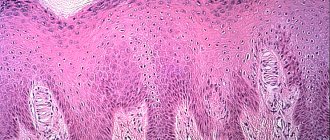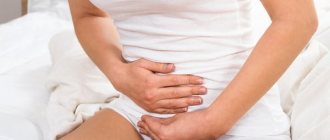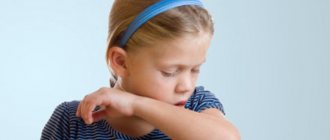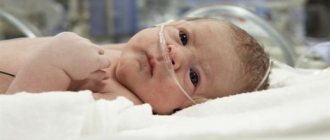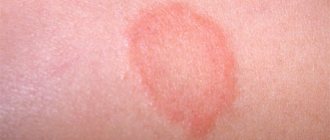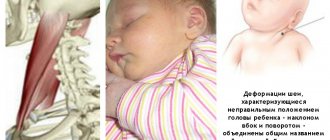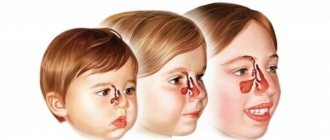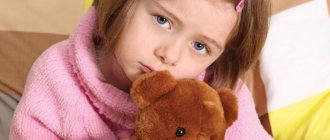Description and photo of ringworm on the child’s body
Fungus infection of children's smooth skin forms typical manifestations.
At the site where the spores enter, a swollen pink spot forms with peeling skin, which has a clear boundary. On the surface of the spot you can see small pimples, inside of which there is yellowish ichor. As the pimples open, crusts remain in their place. As inflammation develops and swelling decreases, the skin turns pink and begins to peel off finely. The lichen zone is surrounded by an inflammatory halo, rising above the surface of the skin, which consists of vesicular grouped elements, under which the skin is inflamed, irritated and swollen, the spot has a round, oval or slightly uneven shape. note
Often, a new ring formation of lichen appears in the center of this formation, for which this typical phenomenon is called a ring within a ring. This is one of the typical signs of ringworm in children, based on which a diagnosis can be made.
The skin around the lichen plaques usually does not change, although options for screening out smaller plaques from the main large one are also possible. Ringworm in children can be found on open areas of the body and those covered by clothing. It especially often affects the face and neck, forearms and shoulders, chest, and back in children. When scratching the elements, ringworm is complicated by the addition of a secondary microbial infection, which leads to suppuration of the elements. This is typical for young children and those kids who have problems with immunity.
Common symptoms
The final clinical picture directly depends on the type of disease. In its advanced form, lichen can cause the patient a lot of uncomfortable and painful symptoms. Experts distinguish three stages of disease development: initial, progressive, active. Each of them has its own characteristics and treatment rules.
The initial stage is characterized by the following symptoms:
- The spots are round in shape and have a clear border.
- The affected area of skin becomes inflamed and swollen.
- If there was hair at the site of the lesion, then characteristic black dots with a whitish coating appear instead.
- The skin is covered with spots that can be pink or red.
- Drying blisters with small crusts form on the head.
When the disease begins to progress, the lichen spots grow rapidly and spread throughout the head. During this period, baldness in areas of epithelial damage is clearly visible. The skin is covered with specific scales of keratinized epidermis. The edges of the spots may take on a lilac hue.
Ringworm in children
The course of the disease is no different in children and adults. The child does not feel discomfort, and his general condition is normal. The center of the lichen lesions is flatter and rough to the touch. The border is covered with crusts and small blisters, and its color is bright red. Moreover, such formations occur both in the scalp and on the body.
Due to the tendency of children to allergies, there is a risk of developing an edematous form of ringworm. The child begins to show anxiety, the reasons for which are:
- Burning and itching at the site of the disease.
- Weakness.
- Temperature increase.
- Disturbances in the gastrointestinal tract.
- Inflammation of the lymph nodes.
Symptoms
One of the main signs of lichen is spots without hair.
There are a number of common symptoms for all types of lichen in cats and kittens:
- hair loss;
- peeling and inflammation of the skin;
- change in pigmentation;
- inflammation;
- severe itching.
Symptoms of ringworm
With ringworm, a cat loses certain areas of its fur. But the disease begins with a barely noticeable small rash under the fur. Signs that should alert the owner are increased anxiety of the animal and frequent scratching. The development of ringworm in cats is characterized by the following:
- round flaky spots appear on the skin, crusts form;
- the fur in the areas where the rash appears thins, the hairs become brittle;
- smooth, reddened skin is visible under the fallen scales;
- the spots expand and take an oval shape;
- the spread of serous-purulent crusts leads to the formation of scabs;
- the areas of skin underneath are completely missing hair; after recovery, it will not be restored;
- If the cat is not treated, the spots will grow, forming extensive areas of baldness.
The spots are painful, itchy, and cats often chew and scratch them. There is also a form of ringworm in which all the described signs are either absent or clearly not expressed. This clinical picture is called atypical. Only individual hairs of the fur are affected. Ringworm is invisible, therefore, a person does not take any measures until the disease is already advanced.
Ringworm symptoms vary depending on the specific pathogen. In some cases, only the cat's head and face are affected, in others the spots spread to the entire body.
Ringworm in cats
Symptoms of versicolor (pityriasis versicolor)
Tinea versicolor initially looks like a small pale oval spot on the skin of a cat or cat. But after a few days the number of spots increases, they grow together, forming lesions of irregular shape. If the fungus gets into the claw, it becomes deformed.
Interestingly, there is practically no itching with this form of lichen. And when it gets colder, the spots may disappear on their own. The affected surface can be either smooth or scaly. Otherwise, pityriasis versicolor is practically no different from its other types.
Pityriasis versicolor in cats
Symptoms of pink (shingles)
Pityriasis rosea can appear as many small spots like an allergic rash, or it can appear as large pinkish spots up to 2 cm in diameter. Most often, lesions appear on the stomach, inner thighs, and groin of the animal. The itching may be slight or sometimes absent altogether.
In the center the spots are flaky, and at the edges the skin is smooth. In severe cases and without treatment, sepsis may occur if pathogenic microorganisms enter and take root in the lesions. Sometimes pityriasis rosea in a cat is accompanied by fever, joint pain, swollen lymph nodes, and general malaise.
Pityriasis rosea in cats
Symptoms of weeping lichen (wetting eczema)
Ringworm in cats and kittens also begins with red spots. The skin in these areas is hotter than the surrounding area and is also very painful. The rash consists of blisters filled with fluid. When these blisters rupture, their contents are released, causing skin infection and the formation of ulcers and crusts. Sometimes shingles is accompanied by a fever. This type of disease is not dangerous for people.
Lichen planus
Causes of lichen
To understand how and how to treat lichen for children, you need to understand the sources of the problem. Ringworm appears as a result of a certain type of virus coming into contact with the skin.
This happens from the simplest contact, direct or indirect. You can get infected not only from other people, but also from animals.
Particularly dangerous in this regard are stray animals that do not have medical supervision and care. Among them, lichen spreads quite quickly, which is why many people, including children, can become infected.
Weak immunity can cause infection. In many cases, minimal contact may not pose a threat because the body's immune system quickly copes with the virus. After a cold or serious illness, a child’s body can become very weak, making him more susceptible to external threats.
Here you can add allergies, increased sweating during hot periods of the year, physical damage to the upper layers of the skin and much more.
Ointments for skin treatment
Having figured out how to treat lichen, you should choose the right drug for treating the skin. It is recommended to consult a doctor about how to quickly remove lichen from your baby’s body.
Typically, antifungal drugs in the form of an ointment are used to treat the skin. Clotrimazole ointment is often prescribed. This drug has a wide range of actions and is effective against ringworm pathogens. Skin treatment is carried out several times a day. The doctor selects the exact treatment regimen. The frequency of use of the ointment depends on the age of the child and the severity of symptoms. The medicine directly affects the fungus, but due to the emollient components in the composition it also helps reduce itching and flaking.
Another effective drug for treating the skin is Lamisil ointment. This drug suppresses the growth of the causative agent of trichophytosis and helps to quickly eliminate symptoms. The course of treatment is a week, but after the symptoms disappear, it is necessary to continue treating the skin for 10 days.
Your doctor may also recommend Mycoseptin for skin treatment. In addition to the antifungal substance, the medicine contains zinc, which has an antiseptic effect and helps accelerate regeneration.
Diagnostic methods
First of all, the doctor conducts a survey to find out the main complaints and the expected source of infection (contact with sick people, animals). Then the lesion site is inspected and samples are taken, which are examined under a microscope.
- Microscopic examination of mushrooms allows you to see the presence of mycelium. However, this method cannot determine which fungus is causing the disease.
- A cultural study involves inoculating material taken from a patient onto a special nutrient medium. This technique allows you to accurately identify the pathogen.
- Fluorescence method in Wood's rays (long-wave ultraviolet radiation, which is used in dermatology for diagnosis). With fungal infections, an emerald green glow of the lesions is observed.
- Additional methods (blood and urine tests are done every 10 days if antifungal drugs are used orally). The purpose of these studies is to monitor the general condition of the body during the period of antifungal therapy.
What are the methods of infection?
Carriers of this disease are both sick people and animals. Most often, stray dogs or cats act as carriers. Puppies and kittens are especially often affected. However, in animals, due to physiology, this disease proceeds much simpler and faster, without greatly affecting the state of health.
The cause of infection may well be another person. Infection can occur through communication or the use of personal hygiene items, such as a towel or comb. The likelihood of the disease increases several times if a person has some lesions or abrasions of the skin, as well as if he has a weakened immune system.
Folk remedies
How to treat lichen on the head in children? Various decoctions, tinctures, lotions and ointments are used:
- Mix beetroot broth with honey (1:1) and lubricate all affected areas. It is not recommended to wash off this mixture.
- Apply garlic and onion pulp, wrapped in a gauze bandage, to the inflamed skin. You should be careful not to let it come into contact with healthy areas of the body.
- Apply the ringworm with a warm mixture prepared from a small amount of hot sulfur (yellow) with olive oil. This procedure is carried out until the sore disappears completely.
- Mix radish pulp with bee honey (1:1) and treat the inflamed areas.
- To get rid of lichen in a baby, you should pour medicinal chamomile with boiling water, cool and rub into the inflamed areas until the disease completely goes away. The duration of this treatment does not exceed several weeks.
Depending on what the lichen on the head looks like in children, it is treated in the following ways:
- In addition to treating the disease itself, the child’s immune system is increased and the body is strengthened.
- You can also finely chop the cabbage and add sour cream, and make such lotions several times a day.
- Many special decoctions can be taken internally, for example, based on celandine, calendula, licorice root and some other plants. To do this, the components are brewed in the usual way: a tablespoon of raw material is poured with boiling water and infused in a dark place for several hours.
- If the lichen is extensive, it is recommended to take special medicinal baths. 100 grams of the medicinal mixture are brewed in a water bath and baths are prepared. It is recommended to take within half an hour.
- If the rashes are severe, then it is advisable to mix St. John's wort, string and chamomile, add boiling water and leave in a dark place for about an hour. Rinse your hair with this solution.
It is advisable to wash your child’s hair with shampoos and conditioners, which are based only on natural products.
- Take 50 grams of honey and fill it with 200 grams of alcohol, then close the lid and leave for several days in a dark place. Then it is recommended to treat the inflamed areas well.
- To make the disease go away from the hair, it is recommended to take a small chicken egg. Separate the white from the yolk and coat the sores with the white, apply cellophane and wrap with a sterile bandage. The effect will be noticed in a few days.
- Black raisins are also used to treat lichen. To make a special medicinal ointment, it is recommended to grind steamed raisins and lubricate the inflamed areas. At the same time, they drink various medicinal decoctions.
It is recommended to enrich shampoos with essential oils based on olives and avocados, as well as rose petals. Some experts advise making a compress with yeast dough. To do this, it is applied to the lichen and kept for several hours. The disease goes away within a few weeks.
You can soak the washed peas in water for a few minutes and then boil them. After it has cooled, lubricate all affected areas for the baby. Thanks to this procedure, you can quickly get rid of skin peeling and itching.
You can also crush cranberries or viburnum (1:1) and lubricate the affected areas for the child (repeat several times a day). Thanks to this procedure, you can forget about the disease in a few weeks.
Treatment of different types of disease
How to treat lichen in a child? First, the doctor must determine the type of pathogen. To do this, a diagnostic study is required - scraping from the affected area of skin for bacterial culture.
Shearer
Treatment of ringworm in children is carried out by a pediatric dermatologist. Depending on the skin lesion, local antifungal agents and oral medications are prescribed.
- Ringworm ointment for children. The most commonly used antifungal ointments are: Mycoseptin, Clotrimazole, Terbinafine, Lamisil, Tolnaftat, Ketoconazole and others. Most of them have age-related contraindications - they are prohibited for children under 2 years of age. You can also smear lichen in a child with sulfur-tar and sulfur-salicylic ointments. In the pharmacy, in the prescription department, special products are prepared: Lassara paste and Vidal's milk. The doctor writes a prescription for these medications.
- Treatment of affected skin. In addition to medicinal ointments, creams, gels, shampoos, antiseptic solutions are prescribed for treating stains: 5% iodine solution and 3% salicylic acid.
- Ringworm tablets for children. Systemic treatment is prescribed for deep and extensive skin lesions, as well as for the chronic stage of lichen. The most commonly prescribed tablets are Griseofulvin. The dosage and course are determined by the doctor according to the age of the child. Treatment is long and can take up to four weeks. Bacterial analysis of scrapings is carried out weekly to determine the effectiveness of the drug. Even if the fungus is not detected, treatment must be continued for another two weeks.
- Assistive therapy. Includes vitamins, immunostimulants, drugs that improve blood circulation and strengthen blood vessels. These remedies are especially important for chronic, deep lichen.
- Treatment with folk remedies. It is important to know that these methods are only auxiliary and should be agreed with your doctor. The most effective remedy is considered to be tincture of propolis and chamomile, which is used to treat lesions on the skin. For lichen on the scalp, you can use a decoction based on the following herbs: horsetail, celandine, string.
The test for ringworm is taken three times: immediately after the course of treatment, a week later and a control test after 2 months. If the fungus is detected again, this indicates that the treatment was either insufficient or incorrect. A different therapeutic regimen is prescribed.
Pink
It is not possible to cure pityriasis rosea in children immediately, but most often it goes away on its own. The disease can last for years until its true cause is determined and the unfavorable factor is eliminated. This disease is often confused with psoriasis, eczema, tinea versicolor, and allergies. Therapy for pityriasis rosea is fundamentally different from the treatment of ringworm and is based more on a number of prohibitions. Which ones?
- The use of antifungal agents is strictly prohibited. Doctors warn that this can lead to a worsening of the process, and there will be more skin rashes.
- Antiseptic solutions and ointments should not be used. Iodine, salicylic acid and ointment, sulfur ointment, alcohol greatly dry the skin and lead to irritation.
- What should you avoid? You cannot take a bath, take a hot shower, use a hard washcloth, rub yourself vigorously with a towel, be in direct sunlight, or wear synthetic clothing. You also need to exclude heavy physical activity and heavy sweating, and highly allergenic foods in the diet.
What remedy for pityriasis rosea in children can be effective?
- Softening oil: peach, rosehip, sea buckthorn, St. John's wort and others.
- Natural antiseptics: celandine tincture, ointments and solutions “Romazulan”, “Chlorophyllipt”.
- Antihistamines 2 and 3 generations help relieve itching.
For extensive skin lesions with inflammation, the doctor may prescribe hormonal ointments for local treatment. Independent use of these funds is strictly prohibited.
girdling
In mild cases, shingles goes away on its own within 2 or 3 weeks. But for any skin rash of unknown nature, the child should be shown to a dermatologist, infectious disease specialist and allergist. How is treatment carried out for moderate and severe forms of the disease?
- Antiviral drugs. The doctor may prescribe antiherpetic drugs for local treatment, oral administration, or less often, the medicine is administered intravenously. After taking antiviral drugs, relief quickly occurs, rashes become smaller, and the pain subsides. The course of treatment lasts about 10 days. Also, drugs based on glycyrrhizic acid are used to treat shingles.
- Painkillers. Prescribed for severe neuralgic pain. These may be medications based on paracetamol or ibuprofen.
- Antibiotics. They are used only if there is a purulent process or a secondary bacterial infection.
- Assistive therapy. To maintain the body and strengthen the immune system, the doctor prescribes vitamin therapy, immunostimulants, and physiotherapy.
When treating shingles, do not use hormonal ointments and creams for topical treatment, as they can aggravate the disease.
Color
How to remove tinea versicolor from a child? The principles of treatment are the same as for ringworm:
- Local treatment with antiseptic solutions.
- Use of local antifungal ointments (antimycotics).
- In case of severe damage to the skin, antifungal tablets are prescribed for a long course.
Lichen planus
A type of lichen that is classified as an autoimmune disease. It is known that lichen ruber is not infectious or viral in nature; it is not transmitted to another person. Despite advances in modern dermatology, it was not possible to determine the exact cause of its development. The disease mainly affects adolescent children, less often infants or primary school children. Doctors in the field of dermatology believe that the main causes of the disease are neurogenic in nature, that is, the disease can manifest itself against the background of nervous disorders, constant stress, anxiety, as well as organic changes in the functioning of the central and autonomic nervous systems. It is not uncommon for lichen planus to occur in children prone to obesity, suffering from liver disease, intestinal disease or diabetes.
With lichen planus, small papules appear on the child’s body, which after a few days turn into ulcers and erosions. Basically, such rashes are localized on the legs, in the lumbar region, neck, and less often the face. The small rash is red-brown in color with a purple tint. After 1–2 days, the rashes begin to merge into spots that form various patterns on the child’s skin.
The disease has a fairly long course, which can range from 1 month to six months. Sipi elements may periodically disappear and reappear. In addition to the rash itself, the child complains of itching and burning of the skin.
If you consult a doctor in a timely manner and prescribe adequate treatment, you can achieve good and quick results. Treatment of lichen planus in children should be carried out comprehensively, using sedative and antihistamine medications. In some cases, the child may be prescribed antibiotics, immunosuppressants, and hormonal ointments. The prognosis after treatment is favorable, but in some cases the disease relapses.
Treatment of ringworm in children
If suspicious spots are detected on the child’s body, it is not recommended to resort to traditional medicine methods, since due to weakened immunity, the disease can only worsen. When the diagnosis is confirmed by a dermatologist, treatment will be prescribed, which in most cases will last up to two months. In addition to local treatment with ointments and special medications, outpatient procedures are also prescribed. Despite the fact that the disease is not dangerous, it is very contagious, so for the safety of the family it is necessary to follow a number of rules:
- Use only personal towels and other personal hygiene products.
- After washing, the laundry must be treated with hot steam, so you need to iron it.
- It is desirable to isolate the patient from society for the duration of treatment, especially from children's groups.
Prevention measures
All parents should know how to protect their child from shingles. After all, preventing a disease is much easier than treating it.
Experts recommend following a few simple rules:
- Treat pets promptly.
- Wash your child's hair with a special antifungal shampoo.
- Do not use other people's hygiene products.
- Diversify your child's diet with foods that contain vitamins, zinc and sulfur.
- Avoid contact with stray animals.
If one of the family members has had shingles, then all his things must be thoroughly washed and ironed with a hot iron, and household items must be disinfected. Upon returning from the street, the child must wash his hands with soap. Each family member should have personal towels, combs and other hygiene products. If lichen is found on a pet, it should be taken to the vet immediately.
Types of lichen on the head in children
There are many types of lichen in children. Only three species are common among infants, preschoolers, and adolescents. Each type has its own causes, symptoms and signs. Each patient must be prescribed individual treatment.
Kinds:
- shearer;
- pink;
- red flat.
Shearer
Another name - microscopy - is the name of the pathogenic fungus - microsporium. Most often it affects the scalp, eyelashes and nails. Children are more often infected - they like to play with animals that are carriers of the disease.
They also become infected through contact with other people's dishes, bedding, towels, and clothing. Children with low immunity usually fall ill, after suffering an acute form of an infectious disease, or people with hypovitaminosis (insufficient amount of vitamins in the body).
It is important, if there is damage to the skin on the head (scratches, abrasions, wounds), to promptly treat the lesions with an antiseptic, because if an infection occurs, ringworm may develop. Week – the period from the first day of infection to the first day of manifestation of the disease
In severe cases, treatment is delayed for one and a half to two months
A week is the period from the first day of infection to the first day of manifestation of the disease. In severe cases, treatment is delayed for one and a half to two months.
Scales begin to form on damaged skin. Spots can be any size. Hair begins to fall out. Over time, the stains may take on liquid and burst. This kind of lichen is considered vesicular. After the blisters rupture, the affected areas will become covered with dry crusts that will protrude above the skin.
Pink
Another name is Zhiber's lichen. This is a viral disease that occurs in children under 10 years of age. The spots resemble an elongated circle in shape. Before the onset of illness, many children may lose their appetite and complain of high fever.
Several spots appear, which in a couple of days can spread to the entire scalp. After another 2 days, the affected epidermis will begin to peel off. Pityriasis rosea “jumps” to the face, neck and chest. But the spots are smaller in size.
As the size of the spots increases, the color in the middle changes to a yellowish-brown. The edges turn red. More often, because of its appearance, pityriasis rosea is called medallion.
Sometimes the spots fill with fluid and rise above the skin. Over time they burst. The course of treatment usually ranges from 1.5 to 2 months. You can become infected through contact with an animal or a sick person.
It is important to isolate the child from others during treatment until complete recovery.
Red flat
Teenagers get sick more often. The exact source of infection is rarely identified.
The reasons may be different:
- Heredity.
- Poisoning with medications (exceeding dosage).
- Virus.
- Pronounced psychogenic emotional reaction (stress).
- Allergy.
Symptoms:
- profuse rashes;
- itching;
- flat papules;
- drop-shaped or polygonal shape;
- purple tint;
- clear boundaries;
- size from 1 to 5 mm;
- shine on the surface of the affected skin.
A week before the onset of the disease, the infected person begins to lose appetite, feel weak and unwell. Only then does a rash appear.
This type of lichen often does not appear on the head. This feature distinguishes it from other species. Liquid does not appear inside the papule.
Why does lichen appear?
Lichen is a group of dermatological infectious pathologies that are of viral or fungal origin. You can become infected through contact with a sick person or animal while using shared toys and things. The disease is often diagnosed in preschoolers. The development of the disease most often occurs in children with weakened immune systems - after a recent cold, or in the presence of chronic health problems.
What factors contribute to infection:
- diabetes;
- stress, nervous and physical fatigue;
- increased sweating - most often the development of lichen is promoted by pathogenic fungi that quickly multiply in a humid environment;
- allergy;
- hypothermia;
- avitaminosis.
Most often, the infection enters the body through scratches and wounds on the skin, so always immediately treat all injuries with antiseptics, cover them with a plaster or a sterile bandage. The peak of the disease occurs in late spring, summer, early autumn.
Types and main symptoms of the disease
The main signs of lichen are skin rashes, itching, peeling, changes in skin pigmentation, and hair loss. But the type and location of the rash varies greatly depending on the type of infectious agent.
How to recognize lichen:
- Ringworm is a fungal form of the disease, most often diagnosed in preschoolers and primary schoolchildren; depending on the type of pathogen, microsporia or trichophytosis is diagnosed. The rashes are pink or reddish, rounded with clear boundaries, with many light scales on the surface. They are localized on the head, neck and face, less often they can be found on the feet, armpits, groin, the affected area swells, at the initial stage of development of the disease there is no itching, but then it appears, becomes unbearable, the hair begins to fall out or breaks off near the roots.
- Pink - the origin of this type of disease has not been fully studied by doctors, but most experts are inclined to believe that it is a viral form of the pathology. This type of lichen never affects the head, neck and face; spots appear on the back and stomach, in the bends of the knees and elbows. At the initial stage of development of the disease, you can see single round or oval pink rashes that begin to peel off and spread to healthy areas of the epidermis. The disease is accompanied by itching, the discomfort intensifies after a hot bath, with increased sweating. Additional symptoms are weakness, headache, nasal congestion, redness of the throat.
- Shingles is a viral herpes zoster, diagnosed in children over 10 years of age, most often in those who have already had chickenpox. Rashes in the form of small bubbles with liquid are located in places where large nerve columns are located - the lower back, chest; in rare cases, the disease can affect the eyes, which can lead to partial or complete loss of vision. The disease is always accompanied by severe pain and unbearable itching. The disease lasts several weeks, after 14 days the blisters burst, become crusty, and after they disappear, spots of a lighter shade remain on the skin.
- Pityriasis versicolor (tinea versicolor) - occurs against the background of infection with yeast fungi; the disease develops mainly in adolescents during puberty against the background of hormonal changes in the body. Pink, brown or greenish spots of different sizes appear on the back, stomach, arms, shoulders, and become discolored under the influence of ultraviolet radiation. The rashes are very flaky, but there is no itching.
Ringworm and shingles are highly contagious. Pink and colored - low, many doctors believe that these forms of the disease are not transmitted from person to person.
With any form of lichen, it is important to strictly follow some rules - postpone walks until the evening, remove all carpets and soft toys for a while, carry out wet cleaning every day, wipe off dust, ventilate the room at least 5 times a day. A sick child should not take a bath; all hygiene procedures should be carried out under running water.
Which doctor should I see for ringworm?
It is important to understand that treatment for ringworm will be long, averaging 4-6 weeks, which depends on the type of disease, the depth of the lesion and prevalence, and the age of the baby. It is important to strictly follow all medical recommendations and refrain from attempting self-medication so that this does not lead to the infection becoming chronic.
Infectious disease doctors or dermatologists are involved in the treatment of ringworm in children; they will carry out measures aimed at ensuring that the infection does not become chronic and does not affect more and more areas.
note
Self-cure from lichen is rare, typical for boys in adolescence, which is associated with changes in the composition of skin secretions (especially the sebaceous glands). Special acids appear there that have a detrimental effect on the fungus.
But you shouldn’t hope for it, treatment is important in all cases
Before starting therapy, the doctor must clarify the diagnosis, since different types of skin infections, including fungal ones, are treated differently. First of all, the doctor will conduct a visual examination of the skin and the elements formed on it, and to determine the fungal infection, he will use a special device - a Wood's Lamp, in the rays of which the fungal affected elements give off emerald green shades of light. To clarify the type of fungus and confirm the diagnosis, a scraping is taken from the affected area and cultured on nutrient media, and microscopy of the specimen is performed. This helps to identify colonies of fungi and confirm the diagnosis of microsporia or trichophytosis. Only after all this can you begin treatment when there is an accurate diagnosis!
Treatment
To make a diagnosis and prescribe adequate therapy, a laboratory examination of skin flakes or nail plates and isolation of a fungal culture are necessary.
Differential diagnosis of trichophytosis is carried out with:
- microsporia;
- rubrophytia;
- favus;
- seborrheic eczema;
- pityriasis rosea;
- athlete's foot inguinal.
The infectious-suppurative form is differentiated from:
- microsporia;
- pyoderma. Here you can read in detail about pyoderma in children.
- psoriasis.
Treatment is a combination of drugs for general and local use. Medications should only be taken as prescribed by a specialist. For single lesions located on the surface of the ugly skin, only external medications can be used.
Systemic drugs
Antifungal drugs are used orally, such as:
- griseofulvin;
- levorin;
- nystatin in an individual dose.
To increase the activity of the immune system, general strengthening drugs are prescribed:
- adaptogens (ginseng, eleutherococcus, lemongrass, roseola rosea, ginger);
- vitamins A and E (which are keratoplastics).
The most preferred antifungal drugs are:
- Orungal (based on itraconazole) and exifin (based on terbinafine). The presented medications are most effective, which allows them to be taken for a minimum period of time 1-2 times a day. Moreover, these products are low-toxic, which means they can be used in childhood.
- Griseofulvin. It is not inferior in effectiveness to the analogues presented above, has a much lower cost, but the number of daily doses increases up to 3 times and the course duration increases up to 6 weeks. In addition, griseofulvin has an inhibitory effect on the immune system and can interfere with the absorption of B vitamins, so its use must be combined with vitamin therapy and immunocorrective drugs (Immudon, Thymalin, Taktivin).
Local treatment
Hair needs to be shaved. This recommendation applies to hair on the head, eyebrows, mustache, beard, and vellus hair located on other surfaces of the body. If the eyelid is affected, it is necessary to manually remove the eyelashes (using tweezers).
Applications with 3% salicylic, tar ointment, Wilkinson's ointment or 2% are applied to the affected area.
There is a huge selection of different antifungal ointments:
- funginal (3 times a day for 20 days);
- mycogel (2 times a day for 20 days);
- exoderil (2 times within 14 days);
- Lamisil (1 time for 7 days);
- exifin (1-2 times for 7 days).
Personal hygiene
Hygiene is one of the most important steps in both the prevention and elimination of ringworm.
Necessary measures to be taken after contact with an infected person or animal:
- treat hands and contacted areas of skin with soap and antiseptic or other antiseptic agents (chlorhexyline, miramistin);
- apply a cream with a fungicidal or fungistatic effect (amiclon, afitin, binafine, canison and others);
- in case of possible damage to the scalp, it is necessary to wash it with shampoo with an antifungal effect (keto-plus, mycozoral, nizoral);
- for preventive purposes, it is very convenient to use fungicidal sprays, which can be used to treat not only your own skin surface, but also other surfaces, to prevent contact and household transmission of infection (Lamitel, Lamisil, Canesten);
- exclude mutual use of objects (combs, clothes, etc.).
Lichen planus: signs and treatment methods
This type of disease is a multifactorial dermatosis. Often the rashes are localized on the scalp, which ends in the appearance of cicatricial alopecia. Hair deprived of nourishment falls out. An atrophic change in the skin is observed, and strong pigmentation appears.
The main symptoms of lichen ruber:
- Small gray elevations appear on the head; in appearance they can be compared to warts;
- In some cases, the rash appears in the form of blisters;
- There is peeling of the skin around the spots and in the center.
In traditional pharmacology, there are no drugs that completely eliminate lichen. Treatment is aimed at eliminating anxiety symptoms. For severe itching, antihistamines and sedatives are prescribed.
If there is a strong inflammatory process, then immunosuppressants of the quinoline group (Delagil) are recommended. The duration of treatment is three weeks. In acute forms of the pathology, corticosteroids are prescribed. Additionally, physiotherapeutic methods are used - acupuncture, electrosleep. Patients are advised to undergo sanatorium-resort treatment.
How to treat lichen, effective medicines
Treatment of any form of lichen involves the combined use of products for external and internal use, since getting rid of fungal infections is not so easy.
How to treat ringworm
Since ringworm often affects the scalp, you need to purchase a shampoo with an antifungal effect - Mycozoral, Nizoral, you can use tar soap.
How to treat pityriasis rosea in a child
This form of the disease often goes away on its own, sometimes lasting for years until the true cause of its occurrence is determined. The therapy is radically different from the treatment of ringworm.
For pityriasis rosea, you cannot use antifungal agents or antiseptics with a drying effect to lubricate the rash.
What can be used? Ringworm on the hand, face, and other parts of the body can be lubricated with peach, rose hip, sea buckthorn oil, Chlorophyllipt solution, Romazulan; modern antihistamines - Zodak, Fenistil - will help eliminate itching. If necessary, the doctor can prescribe hormonal medications, but you cannot take them yourself.
Treatment of herpes zoster
The basis of therapy is antiviral drugs - Acyclovir, Famvir, Valtrex; treatment will be effective if you start taking the drugs no later than 72 hours after the first signs of the disease appear.
Additionally, painkillers are prescribed - Ibuprofen, Panadol.
You cannot use ointments and gels with corticosteroids, as they provoke an exacerbation of the disease.
For any form of lichen, it is necessary to take immunomodulators - Polyoxidonium, Cycloferon, Immunal. If the disease is severe and there is a risk of bacterial infection, the doctor may prescribe broad-spectrum antibiotics - Erythromycin, Metacycline.
How long to treat lichen? The duration of the course is determined by the attending physician; if you start therapy when the first signs of pathology appear, then unpleasant symptoms can be eliminated in 7–10 days; in advanced forms, treatment can last for several months; fungal infections are often recurrent.
Shingles
Shingles is least common in children. The fact is that shingles occurs in the elderly, and in children the same virus causes chickenpox. The clinical picture of chickenpox is pronounced and is accompanied by both an increase in body temperature and the appearance of small blisters on the body that burst, forming small ulcers. In addition to the rash, there is itching, and catarrhal symptoms may occur. Treatment consists of cauterizing the rash with an alcohol solution of brilliant green, as well as taking antihistamines and antipyretics. Chickenpox is an acute infectious and quite contagious disease. After an illness, the child develops immunity, which prevents him from getting sick in the future.
Causes of ringworm
Favorable conditions for the development of the fungus are crowded conditions of people, especially in cities, an abundance of homeless animals, unsanitary conditions, high temperature and humidity. Sick animals and humans carry fungal infections. Fungal spores can also be picked up through household items: toys, combs, hats, washcloths, and tools in hairdressing salons.
A factor in the manifestation of a fungal infection in a child can be:
- weakened immune system;
- overwork;
- improperly organized diet, lack of vitamins;
- ARVI;
- various allergic reactions;
- increased sweating;
- minor skin lesions.
The disease can begin in childhood and become chronic. The pathogenesis of chronic trichophytosis includes endocrine disorders, autonomic nervous disorders and a lack of vitamin A. All these factors reduce the body's immune resistance.
